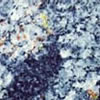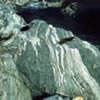
Outline
The Omi River Basin, formed by plate subduction hundreds of millions of years ago, contains large amounts of jade, crystalline schist, serpentine, and other rare minerals usually only found deep within the earth. Beautifully colored jade, contrasting striations on metamorphic rock, and newly discovered minerals such as ohmalite, nunakawaite, and itoigawaite illustrate the romance and mystery of the subterranean world below us. Thanks to the unusual topography of this region, we can easily observe and touch these rare minerals usually hidden deep underground.
Even though the Jade Gorge has been designated and preserved as a National Natural Treasure, it has not avoided damage inflicted by careless jade thieves. Deposits which have been unfortunately damaged by illegal digging have been removed to the Jade Village Center at Oyashirazu Pier Park and the Omi Museum of Natural History for preservation.
If you climb the slope up Kanayama Valley, you can find deposits of Ohmilite and Nunakawaite encased in deposits of albitite, a very rare rock found nowhere else in Japan. Also, in the Omi River, flecks of gold still can occasionally be found from the now abandoned Hashidate Gold Mine located upstream.
1. Omigawa Jade Gorge
 Omigawa Jade Gorge
Omigawa Jade Gorge
Compared to the Kotakigawa Jade Gorge, the Omigawa Jade Gorge is much more rugged and difficult to access. But don't let that deter you! The Omigawa Jade Gorge is home to astounding jade boulders scattered along the near riverbank. These white boulders contain green, blue and lavender-colored jade which can also be found along the Omi, Oyashirazu and Ichiburi coasts. When the river is low, visitors can easily touch and climb on the top of these boulders to better examine raw jade in its natural form!
Parking is limited and the trail to the jade gorge is steep. Please dress appropriately and prepare for light hiking.
※The Omigawa Jade Gorge is a National Natural Monument and is protected by Japanese Law. Removal or damage of plant, wildlife, or geological material is strictly prohibited. Please cooperate with us in the protection and conservation of this rare natural wonder.
2. Albitite Boulders & New Minerals
 Albitite Boulders
Albitite Boulders
Large boulders of a mineral called albitite can be found in the upper reaches of the Kanayamadani River, a small tributary of the Omigawa River. Chemically, albitite is relatively similar to jade and they often are found in the same location. Because of this, jade was long thought to be formed from albitite subjected to extreme pressure, but recent evidence suggests this theory may not be correct.
These boulders of albitite are particularly special because they contain rare minerals called ohmilite and nunakawaite. These minerals were first discovered in Itoigawa in 1971 and this is reflected in their names. Ohmilite is named for the Omi region and nunakawaite is named for local goddess Princess Nunakawa.
※The Kanayamadani River Valley is a designated conservation region and is protected by the Environmental Protection Bylaw of Niigata Prefecture. Removal or damage of plant, wildlife, or geological material is strictly prohibited. Please cooperate with us in the conservation of our geological heritage.
3. Crystalline Schist Formations
 Crystalline Schist
Crystalline Schist
Further up the Omigawa River from the jade gorge are formations of crystalline schist. This striking rock is characterized by its easily visible stripes and thin, leaf-like flakes. Because it is made up of these flakes, schists split very easily. In fact the name "schist" is related to the word "schism," both coming from a Greek word meaning "split."
Schist is formed by intense geological processes deep beneath the Earth's surface. The power of these forces can be seen in the sharp bends and breaks in the schist’s striations.
Route to Omigawa Jade Gorge Geosite
| Departure: | |
|---|---|
| Destination: | |